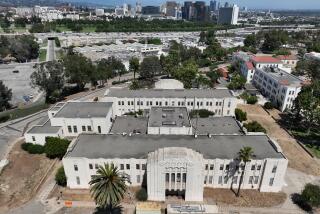Hospital to Uproot 240 Families : County-USC Medical Center’s $1-billion project for a modern facility will begin next year. Longtime residents are angry.
County-USC Medical Center plans to displace 240 families east of its Boyle Heights campus as part of a $1-billion expansion and construction project that will eventually replace the 1930s-era General Hospital.
The eight-year project, which is scheduled to begin next year, will consolidate the four hospitals on the site into one large building and reduce the number of total beds from 1,400 to 950. It would also force cuts in the 9,000-member staff by an undetermined amount, said executive director Jerry Buckingham.
Officials say the neighbors can start selling their homes to the county by year’s end or wait as long as two years from now to sell and relocate.
Neighbors of the hospital, many of whom have lived in their turn-of-the-century homes for 40 years or more, complained that county officials neglected to include them in talks about expanding the 72-acre campus.
Carrie Sutkin, planning deputy for County Supervisor Gloria Molina, conceded that at times project workers could have provided more information to the community and that longtime residents and senior citizens are angry at the prospect of relocation.
“This is, unfortunately, one of those tough decisions that had to be made,” Sutkin said.
Altogether, 77 properties are targeted for the buyout, which will go to the Board of Supervisors for consideration in September after a series of hearings over the summer.
“Here, my children grew up and my grandchildren too, and here my mother died,” said Francisca Fernandez, 69, who has lived in one of the targeted homes since 1959. “There are many memories here. There’s no way they will compensate us for those memories. And then I’m supposed to go to a neighborhood where I don’t know anyone?”
Fernandez, whose lot contains a rental home that provides her an income, fears she won’t be able to find a similar arrangement elsewhere.
The neighborhood consists of single-family homes and a sprinkling of rental units on the steep streets of Cummings, Chicago, Charlotte and Cornwell and some businesses on Marengo.
Another neighbor, Lorenzo Canales, moved to Cummings Street in 1953 after the city bought out his home in Chavez Ravine for a project that eventually evolved into Dodger Stadium. Referring to government officials, he said, “Once their plans are made, there’s nothing that’s going to stop them.”
From the front lawn of the homes atop Cummings Street, there are sweeping views of the Downtown skyline. Aurelia Martinez, 90, relies on her friends down the street to maintain her flower garden. “Who am I going to call when I need help? We’ve been neighbors for so many years,” Martinez said to Amparo Juarez.
The Marengo Heights Neighborhood Assn. has been revived to fight for fair prices. County officials maintain that residents will be given fair-market value for their properties and financial assistance with relocating and closing costs.
“If they disagree (with the county’s assessment of fair-market value), they can hire their own appraiser and negotiate a price,” said architect Elvia Fernandez, a county consultant on the project. “We’re not really taking their property. This saves them money because there’s no agent cost for their appraisal, we’ll pay the closing costs and help them find a new place.”
The county has tried at least twice before--in 1963 and 1975--to replace General Hospital because it does not meet air-quality or fire and safety codes, Fernandez said. Those efforts failed because the county could not come up with enough money on its own, she said.
The current plan, approved by the board in 1990, is moving forward with the help of state financing under a bill to provide capital funds for hospitals with many Medi-Cal patients. Because 40% of the hospital’s patients are covered by Medi-Cal, that percentage of the estimated $960 million that will be needed for property acquisitions and construction will be paid by the state, Buckingham said.
After demolition begins next year, the first phase of construction will get under way in 1995 with a 3,000-space parking garage on the south side of Marengo Street. In 1997, the current parking garage, the AIDS clinic and an outpatient clinic will be demolished to make way for an outpatient clinic and the new medical center.
The new building will have six- to 15-story wings with half its rooms single and the other half double, Fernandez said.
The shutdown of General Hospital will mark the end of an era for the often-photographed building that is featured on the ABC daytime soap opera of the same name. The years have worn down its efficiency, forcing modern standards on a relic of the past and increasing costs. To avert a fire disaster, for example, the hospital employs a “fire watch” team that roams the halls every day searching out hazards because the building is not equipped with a sprinkler system or sufficient exits.
The building also lacks air conditioning, and the electrical system cannot deliver the power needed for new technologies developed because the building was completed in 1932, Fernandez said. Plans are under way to convert it to an office building after the new hospital is built.
More to Read
Sign up for Essential California
The most important California stories and recommendations in your inbox every morning.
You may occasionally receive promotional content from the Los Angeles Times.










